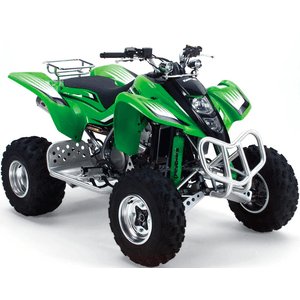Kawasaki KFX 400 (2003–2006) Review: A Sport Quad That Still Thrills
Introduction
The Kawasaki KFX 400 arrived in 2003 as a bold entry into the sport ATV segment, blending motocross-inspired agility with trail-riding durability. Designed to compete with established rivals like the Honda 400EX and Suzuki LT-Z400, this liquid-cooled powerhouse quickly earned a reputation for its lively engine and sharp handling. Even two decades later, the KFX 400 remains a favorite among riders who crave a no-nonsense, adrenaline-pumping experience. After spending a weekend thrashing a well-maintained 2005 model through muddy trails and open fields, here’s why this quad still deserves attention—and why its aftermarket potential keeps it relevant today.
Design and Build Quality
The KFX 400’s design screams “sport” from every angle. Its aggressive plastic bodywork, angular fenders, and twin-headlight setup give it a race-ready aesthetic that hasn’t aged poorly. The steel frame feels robust, though it adds noticeable heft compared to modern aluminum setups. At 175 kg (386 lbs), the KFX isn’t the lightest in its class, but that weight translates to stability at higher speeds.
The narrow seat prioritizes control over comfort—a trade-off that becomes apparent during long rides. Standing up on the pegs feels natural, thanks to a well-positioned handlebar and intuitive cockpit layout. Ground clearance sits at 250 mm (9.8 inches), which handled rocky trails admirably during my test ride, though deep ruts required cautious line choices.
Engine and Performance
At the heart of the KFX 400 lies a 398cc liquid-cooled, four-stroke single-cylinder engine producing 38 HP (28 kW). The power delivery is linear but punchy, with a satisfying surge around 6,000 RPM that pulls hard through the mid-range. The carbureted setup (a Mikuni BSR36) responds crisply to throttle inputs, though cold starts occasionally demanded patience.
During my ride, the KFX climbed steep hills without bogging down, though it lacks the low-end grunt of its air-cooled competitors. Revving out the engine to its 9,500 RPM redline is where this quad shines, emitting a throaty exhaust note that’s music to any rider’s ears. The 5-speed transmission shifts smoothly, and the manual clutch allows for precise control—whether you’re crawling through technical sections or ripping across open terrain.
Key Maintenance Insight:
- Oil Changes: Kawasaki recommends SAE 10W/40 oil (2.1 liters with filter). Regular changes every 30-40 hours are critical to protect the high-revving engine.
- Valve Adjustments: Cold valve clearances are tight (intake: 0.10–0.20 mm / 0.004–0.008 in; exhaust: 0.20–0.30 mm / 0.008–0.012 in). Check every 100 hours to prevent performance drops.
Handling and Suspension
The KFX 400’s suspension setup remains one of its strongest assets. The independent double-wishbone front suspension offers 185 mm (7.3 inches) of travel, soaking up whoops and roots with ease. Out back, the swingarm-equipped rear suspension provides 200 mm (7.9 inches) of travel, though it feels slightly softer under hard acceleration.
Steering is precise, with a turning radius tight enough for wooded trails. The factory-installed Maxxis tires (21x7-10 front, 20x10-9 rear) provided decent grip in loose dirt, though upgrading to modern knobbies would enhance performance. Tire pressures (0.28 bar front / 4 PSI, 0.3 bar rear / 4.35 PSI) are ideal for traction but require frequent checks.
Braking is handled by hydraulic discs front and rear. While adequate, the rear pedal lacked bite during abrupt stops—a common gripe that’s easily remedied with aftermarket pads.
Competition
The KFX 400 faced fierce rivals in its era:
- Honda 400EX: Air-cooled and bulletproof, the 400EX offers more low-end torque but falls short in top-end power. Its suspension is plusher, making it better for casual trail riders.
- Suzuki LT-Z400: Nearly identical in specs, the LT-Z400 edges ahead with a slightly stiffer chassis and better stock shocks. However, its maintenance demands are higher.
- Yamaha Raptor 350: Lighter and nimbler, the Raptor excels in tight trails but lacks the KFX’s high-speed stability.
The KFX 400 strikes a balance between raw power and agility, though it demands more mechanical sympathy than the Honda. For riders willing to tinker, it’s a rewarding platform.
Maintenance
Owning a KFX 400 means staying proactive with upkeep:
1. Chain and Sprockets: The 14/40 sprocket combo and 96-link chain wear quickly under hard use. Inspect every 15 hours and consider upgrading to an O-ring chain.
2. Cooling System: The 1.1-liter coolant capacity is minimal for a liquid-cooled engine. Flush annually and monitor temps during slow-speed crawling.
3. Carb Tuning: The air screw’s factory setting (2.25 turns out) works for sea level, but adjustments are needed for elevation changes.
4. Spark Plugs: The NGK CR7E (gap 0.8 mm / 0.031 in) fouls easily if the carb runs rich. Keep spares handy.
MOTOPARTS.store Recommendations:
- Upgrade to a high-flow air filter for better throttle response.
- Swap stock brake pads for sintered metal variants.
- Install a CV4 silicone coolant hose kit for durability.
Conclusion
The Kawasaki KFX 400 isn’t just a relic—it’s a testament to the golden era of sport ATVs. Its engine thrills, its suspension handles abuse, and its design still turns heads. While it demands diligent maintenance, the aftermarket support (including MOTOPARTS.store’s extensive catalog) ensures this quad can be tailored to modern standards. Whether you’re resurrecting a barn find or optimizing a well-loved model, the KFX 400 rewards those who invest in it.
Ride hard, maintain harder.



















